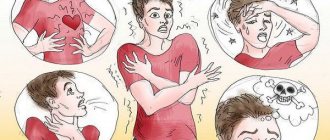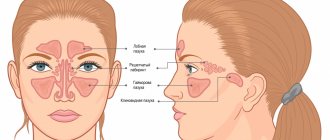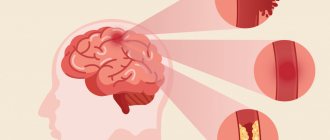Autumn and winter are the period of colds and the spread of viral infections. It is during this time that the incidence rate increases significantly. For some people, distinguishing the flu from a cold can be difficult. Although these two diseases are similar in symptoms, course and even cause, treatment for the flu and colds can be very different. And incorrectly prescribed medications can only worsen the situation.
How to distinguish the flu from a cold - we'll figure it out in this article.
How is the flu different from a cold?
- Onset of the disease . Flu symptoms develop rapidly. And it progresses quickly in the body.
The source of influenza is sick people during the incubation period or the height of the disease. The disease is transmitted by airborne droplets when sneezing, coughing, shaking hands, and also through dirty food (it has not been thermally processed enough). The infection begins to manifest itself in the period from 4 hours to 3 days. In general, the disease goes away in 5-7 days.
A cold is a disease of the body associated with hypothermia. A cold develops gradually, progressively, and painful symptoms appear within a day or two. It is usually easy to treat. But in advanced forms it can develop into other more severe diseases.
- Temperature . With the flu, there is a high body temperature, which can reach 39-40 degrees. With a cold, the temperature usually remains at the standard level.
- Weakness . People with a cold often ignore symptoms such as cough and runny nose, thinking that it will “go away on its own” with time. A cold can be carried on your feet, although it is undesirable.
But during the flu, the patient immediately realizes that he is sick; often he cannot even have the strength to get out of bed. Aches all over the body, severe headache, fever - these symptoms cannot be confused with anything else.
- Cough and runny nose . During the flu, these symptoms do not appear immediately (only after 5 days), and may not appear at all. With a cold, a debilitating cough, sore throat when swallowing and a runny nose are noted.
- Red eyes, itching and watery eyes . The picture of the flu is complemented by red eyes, severe weakness, fever, and bursting blood vessels in the nose. And in severe forms, even convulsions, vomiting, rapid heartbeat, and lack of air are possible.
When you have a cold, your eyes do not turn red or water, and if this happens, it is more likely to indicate a bacterial infection.
Headache after flu
The disappearance of an infection does not always mean a quick recovery. Depending on the general physical condition, mild or intense symptoms continue for many people for some time. More often this is asthenic syndrome - a consequence of exhaustion of the nervous system in the fight against the disease. Its usual signs:
- dull headaches: periodic, without clear localization;
- increased drowsiness, apathy;
- fast fatiguability.
The discomfort disappears within 1–2 weeks. The asthenic “tail” of the flu often indicates chronic fatigue syndrome, hypovitaminosis or hidden endocrine disorders.
You need to be wary of the development of complications if the pain does not go away for several weeks and even increases, although all the signs of the flu have completely passed. The most serious causes of this condition:
- arachnoiditis: infection of the arachnoid membrane of the central nervous system, headache is accompanied by nausea, sleep disturbance, memory loss, sharply intensifies with physical exertion and sudden movements;
- meningitis: acute inflammation of the brain, characterized by a severe course, manifested by intense excruciating pain, confusion, requiring immediate hospitalization.
Why is it necessary to distinguish between these diseases?
The group of people with weakened immune systems includes pensioners and children, people with chronic diseases. This means that their immune system is most susceptible to attack by pathogens. An incorrect diagnosis can lead to deterioration in the functioning of the entire body and incorrect treatment.
Due to influenza, the natural functions of the immune system are weakened, against the background of this, other infections can join and develop. These are mainly respiratory tract infections: the lungs are affected by streptococcal or staphylococcal flora. This contributes to the development of pneumonia, pulmonary hemorrhage, and edema.
Influenza in adults can be complicated by the development of sinusitis, sinusitis, pericarditis and acute cardiovascular failure. Influenza in children is complicated by otitis media, focal pneumonia, and bronchitis.
Diagnosis of flu and colds
If you suspect a disease, you should seek help from a doctor. For adults - a therapist, for children - a pediatrician. The consultation takes place in several stages.
- Initial examination. The doctor will ask you questions about your health, review your medical history, and refer you for tests and diagnostics. After a private consultation, the therapist prescribes an ultrasound of internal organs and laboratory tests to detect viruses and infections.
- Establishing diagnosis. After collecting anamnesis, the specialist will identify the disease based on the results obtained. He will tell you about the causes of your condition, prescribe treatment with various methods and drugs, or refer you for hospitalization.
- If necessary, the therapist will refer you to a specialist for further examination.
As for the examination of the child by the pediatrician, parents must be present. This helps the doctor quickly find a common language with the patient. Initially, the pediatrician listens to the lungs, measures the child’s body temperature, and examines the throat for inflammation.
The specialist listens to parents' complaints about the child's health. After this, it is necessary to undergo an examination to diagnose the disease. The pediatrician will order a blood/urine test, as well as additional tests if necessary (scraping, x-ray, bronchoscopy). At a follow-up consultation, the specialist will make a diagnosis, prescribe medication, or refer you to a specialized specialist.
What symptoms indicate the development of complications?
The clinical picture of complicated influenza includes worsening of existing symptoms or the appearance of new ones. Typically the duration of the febrile period is 3-4 days. During this time, the patient remains intoxicated, which manifests itself in the form of weakness, lethargy, headaches, refusal to eat, and increased drowsiness.
On the 3rd day, a dry cough often begins, accompanied by unpleasant sensations in the chest. Then the body temperature gradually decreases, the patient subjectively feels better. If the flu symptoms intensify, new complaints are added to them, or the patient’s condition becomes severe from the first day, they speak of the development of complications. You should pay attention to such warning signs as:
- shortness of breath, cyanosis, hemoptysis, chest pain;
- decreased blood pressure;
- disturbances of consciousness, pathological drowsiness;
- epileptic seizures, muscle weakness, impaired motor functions;
- dehydration: decreased volume of urine excreted, drop in blood pressure, collapse when trying to stand up;
- the appearance of cough with sputum;
- wheezing in the chest on auscultation;
- duration of fever up to 5 days or more;
- repeated increase in temperature after 3-4 days of illness.
Patients at risk deserve special attention: they have the highest incidence of deaths.
How are colds and flu treated?
Hospital mode
The first thing the doctor will prescribe for such a disease is bed rest. Carrying an illness on your feet is extremely dangerous for both you and those around you. The influenza virus is highly contagious. Everyone you come into contact with will also get sick. You, in turn, risk getting a bacterial complication of the flu.
It is also necessary to adhere to a certain diet: try to drink as much warm drink as possible (herbal teas, milk with honey, berry fruit drinks, water), do not eat heavy fried foods. If you or your child suffering from a disease does not want to eat, there is no need to force it. Decreased appetite is a common symptom of the disease.
Drug therapy
First of all, antiviral drugs are prescribed for influenza and colds , which inhibit the vital activity and spread of the virus inside the human body. Such medications are prescribed for severe or moderate severity of the disease. The drug is most effective in the first days of the disease.
Antipyretics are used only at very high temperatures to help the body cope with the fever and prevent complications from developing. These drugs also have an anti-inflammatory effect.
Antibiotics for colds are taken only after a doctor's prescription. When, against the background of the development of influenza, an acute bacterial infection appears that the body cannot cope with on its own. Important: if you start taking antibiotics, the course cannot be interrupted.
Antihistamines relieve the unpleasant consequences of the disease, such as redness, itching, lacrimation, swelling of the nasopharynx and nasal discharge.
Immunostimulants help strengthen the body's defenses and help the immune system independently repel attacks from viruses and bacteria.
Drops for a runny nose relieve swelling of the mucous membrane, allow the nose to breathe normally and prevent the occurrence of microbial complications. However, the drug should not be taken for more than 5 days, because there is a risk of chronic swelling of the mucous membrane.
Treatment options
Considering why a cold causes headaches, treatment can only be symptomatic. Until the body defeats the infection, unpleasant symptoms will persist.
If the headache is caused by nasal congestion, it can be easily relieved with vasoconstrictor drops. Tizin, Xylene, Naphthyzin are suitable for this. They can be used for no more than 3 days. Otherwise, there is a risk of developing addiction to the drug, which will create inconvenience when discontinuing it.
Head pain during colds is eliminated with the help of non-steroidal anti-inflammatory drugs. They have several effects at once:
- antipyretic - reduces temperature;
- analgesic - relieve pain;
- anti-inflammatory - reduce the severity of inflammation.
Most drugs in this group are sold in pharmacies without a prescription, so absolutely anyone can buy them. For children and those who have difficulty swallowing solid medications, medications are available in syrup form. They are dosed using a special syringe without a needle with marked divisions. Adults can take the drugs in capsule or tablet form. The dosage is indicated in the instructions and on the packaging.
To relieve headaches due to colds, medications based on ibuprofen or paracetamol are best suited. Popular among them are the products of the same name, as well as Nurofen and Panadol. Also suitable for relieving symptoms of a cold are Ketoprofen, Analgin and Citramon (the latter contains caffeine, so it is not recommended to use it at night).
Numerous effervescent tablets and powders will also help relieve headaches. Most of them contain three active components:
- a loading dose of vitamin C to support immunity;
- paracetamol to relieve pain and reduce body temperature;
- Pheniramine maleate acts as an antihistamine, that is, it helps relieve swelling of the mucous membranes of the respiratory tract.
Such drugs include Antigrippin, Theraflu, Fervex, Rinza and other soluble powders. Before using the medicine, you should carefully read its composition. If it contains caffeine, it is better to take the medicine no later than 3 hours before bedtime.
Read also: Dry paroxysmal cough
Dear patients! Remember that only a qualified doctor can make an accurate diagnosis, determine the causes and nature of the disease, and prescribe effective treatment. You can make an appointment with our specialists or call a doctor at home by calling 8-(4822)-33-00-33
Be healthy and happy!
Prevention of flu and colds
The most reliable way to prevent influenza is vaccination. The flu shot is effective, but does not provide long-term immune protection, so vaccination should be done annually. Regular flu vaccination increases the production of antibodies to the virus.
The vaccine has no side effects, and the improved composition protects against mutated strains of the virus. Timely vaccination prevents infection. Even if infected, the disease will be mild.
After getting a flu shot, your temperature may rise to 37.5℃, you may experience chills, sweating, a general feeling of weakness and poor appetite. Redness, slight swelling, itching and pain may be observed at the injection site. This is an indication that your body is developing immunity to the flu. After vaccination, it is strictly forbidden to visit a bathhouse/sauna, swim in open water, engage in tiring physical activity, or drink alcohol.
Contraindications to the flu vaccine
- at least 6 months have not passed since the last vaccination;
- bronchial asthma;
- allergic reactions;
- iron deficiency;
- diseases of the respiratory system in acute or chronic form;
- allergic reaction to chicken protein;
- heart failure;
- endocrine diseases;
- blood pathologies;
- first trimester of pregnancy;
- severe renal failure;
- period of exacerbation of chronic diseases.
To prevent flu and colds, follow a few simple rules:
- Strengthen your immune system. Exercise more often or give your body light exercise. Take a walk in the fresh air, this will saturate your lungs with oxygen.
- Avoid hypothermia. This occurs due to a sharp temperature change and the action of the air conditioner.
- Use antibacterial agents, especially during cold season.
- Eat a balanced diet. This will provide the body with the necessary microelements.
Headache when coughing
A short-term headache when coughing occurs due to increased intracranial pressure during coughing. A typical attack does not last long – 20–30 seconds. It disappears when the cough ends. Similar painful attacks occur with cervical neuralgia and osteochondrosis. During coughing, turning the neck and tilting the head, the nerve endings are pinched, which leads to unpleasant sensations. Pain with cervical osteochondrosis always intensifies during coughing, since the act of coughing is accompanied by slight compression of the nerve structures located next to the cartilaginous tissues of the spine. In this case, the source of pain is often localized in the back of the head, accompanied by dizziness, a feeling of fullness and tinnitus. Osteochondrosis of the cervical spine occurs with impaired blood circulation in the brain and can cause dangerous complications. Therefore, do not delay visiting a specialist, especially if pain attacks occur regularly.
Where to get diagnosed and treated for flu and colds in Krasnoyarsk?
This can be done at the Medunion private medical clinic.
Is a child or an elderly person sick? Then do not wait to see a doctor, but simply call a specialist at home. It's not only fast, but also very convenient! The specialist will examine the patient in a familiar environment, prescribe tests, and prescribe the necessary treatment. And the nurse will take samples or vaccinate you.
Sign up for a medical appointment and take care of the health of your loved ones. You can do this in any way convenient for you - online or by phone on the website. The cost of an initial consultation with a doctor starts from 1100 rubles.











